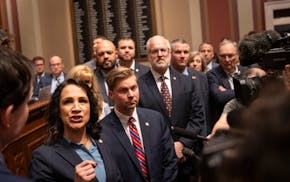CHATFIELD, Minn. — Rocky Burnett is having a difficult time trying to staff overnights and weekends at Chatfield Ambulance service.
He has two full-time workers, including himself, and about 25 volunteers, but it's a struggle to keep those volunteers on call: Burnett pays them a stipend of $2.16 per hour to drop what they're doing and staff an ambulance, which could take hours away from work or school.
"It's a tough business right now," Burnett said. "It doesn't attract well enough to get a good base of people."
Ambulance companies across rural Minnesota are scrambling as they confront massive staff and volunteer shortages as workers seek jobs with better pay and work conditions. The staffing hardship comes as demand for emergency medical services grow, whether it's responding to heart attacks, car crashes or other emergencies.
Rural ambulance advocates are turning their attention to raising federal reimbursement rates, which have failed to keep pace with inflation and hurt rural providers most because they have lower call volume than counterparts in busy metro areas. They want to change stringent regulations on how they're paid, redefine decades-old service boundaries and potentially seek more local funding through tax levies or special districts.
"This is probably one of the most important things coming up in the next 10 to 20 years as people, particularly in rural areas, get older and older," said Kelly Asche, a researcher with the Mankato-based Center for Rural Policy and Development.
The center released a study of rural ambulance services in April highlighting ongoing challenges in the industry and offering potential answers. Since then, the center has partnered with health care and ambulance industry experts in Minnesota to host forums across the state, including one scheduled Wednesday in Rochester.
No one solution could address the complex web of issues threatening ambulance services, but the underlying issue lies with how ambulance services are reimbursed for their work.
In addition, insurance company reimbursement rates tend to follow state and federal rates. Urban and suburban services can make up the difference with increased calls, but rural services with lower call volumes can't take advantage of the economies of scale.
Funding issues lead to staffing issues. Experts say volunteers and full-time staff are underpaid for the work they do as the money goes into equipment and vehicles more often than not.
"I think it's really getting to a point of, do we need to get to the public outcry where people are dying because they don't get an ambulance to answer their call before change can happen?" Asche said. "We can make the change now."
What hurts the budget
Angie Jarrett oversees four full-time paramedics and more than 40 on-call volunteers for the ambulance service in Dodge Center, Minn. It handles about 1,100 calls annually, an average of about three to four calls each day within Dodge County.
Yet turnover at Dodge Center Ambulance Service is ongoing — Jarrett has hired 53 workers over the past three years.
"That's a problem in itself," she said. "And that's because we don't pay them. We don't pay them because we can't afford to pay them."
Tim Malchow, EMS chief with the city of Cannon Falls, Minn., has four full-time staff members and 16 on-call volunteers. But he hopes to hire two more paramedics in the coming months.
Still, inflation, supply chain issues and insurance increases are eating into his budget.
His department budget increased 3% this year, but in reality lost about 6% in large part from increasing insurance premiums as more full-time workers across the industry apply for disability or quit because of post-traumatic stress disorder.
Malchow used to take about 15 minutes to order supplies from vendors, but supply issues and increased costs mean it could take up to half a day to track down what he needs.
"I'm shopping multiple vendors just to make it happen and paying premium cost," he said. "Just trying to find a decent cost is part of it too."
Regulations and policies cut into the bottom line as well.
EMS providers are paid based on patients taken to the hospital, but there are loopholes that affect how much ambulance services are reimbursed.
Medicaid or Medicare coverage doesn't kick in if paramedics or emergency medical technicians treat someone at the scene without a ride to the hospital. And rides only qualify for the trip to the hospital — the return trip isn't covered, which can hurt the bottom line for ambulances in rural areas.
Even certain medications fall under state and federal rules. Burnett said he often wonders why he has to buy a $300 EpiPen to treat patients with severe allergic reactions when he can make do with a $10 bottle of epinephrine and a medical needle.
"If we could use that, it would be significantly cheaper," Burnett said. "But our Legislature hasn't allowed us to be able to do that yet."
In a report this year on EMS providers, Minnesota's Office of the Legislative Auditor said 61% of ambulance service directors who responded to an agency survey had difficulty staffing shifts in the previous month "at the level needed to adequately respond to 911 calls." In addition, 30% of responders said they didn't feel confident their service could meet community needs five years from now.
Industry experts say the best hope for an immediate funding fix lies with city and county governments. Mark Jones, executive director of the Minnesota Rural Health Association, said EMS providers must push for tax districts and potential levy referendums in the communities they serve. Failing that, he said, they may have to look at consolidating services.
"It's a difficult conversation, but it's an easier funding stream to tap into than changing Medicare payments," Jones said.
Federal officials are collecting reimbursement data over a five-year period as part of a review of ambulance funding formulas. And Minnesota's congressional delegation recently urged the Department of Veterans Affairs to revise eligibility requirements for veteran ambulance rides, which would reimburse veterans who need to be transported to in-network, non-VA hospitals regardless of their disability rating.
On the state level, the Minnesota Legislature brought forth several bills this year that would have provided aid to ambulance services, as well as money for training and scholarships for paramedics and other workers.
Yet lawmakers stalled on those efforts after failing to pass a finance bill. And it could take years for federal reimbursement changes to take effect.
"We're going to continue to have staffing issues and funding issues until the state of Minnesota can deem EMS an essential service and dedicate moneys to helping fund EMS services," Burnett said.
New Minnesota GOP leaders seek peace with party's anti-establishment wing

Who is Republican Lisa Demuth, Minnesota's first House speaker of color?

Minnesota House GOP, Secretary of State Steve Simon return to Supreme Court
Supreme Court sides with DFL and Simon, says 68 House members needed for floor action

